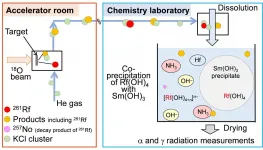IU researchers find disease-related gene changes in kidney tissue
Discovery signifies potential for revolutionary new genetic approach to treatment of kidney disease
2021-02-16
(Press-News.org) INDIANAPOLIS--Researchers from Indiana University have identified key genetic changes in the interstitial kidney tissue of people with diabetes, a discovery that signifies the potential for a revolutionary new genetic approach to the treatment of kidney disease. They will contribute their findings to the Kidney Precision Medicine Project's (KPMP) "cell atlas," a set of maps used to classify and locate different cell types and structures within the kidney.
They shared their groundbreaking findings in a study published on February 10, 2021, in Science Advances.
In the study, researchers investigated the kidney tissue of healthy people and people with diabetes using a technique called "regional transcriptomics." This technique involves a rapid stain of kidney tissue, and then using a laser to cut out microscopic regions of interest.
They found that important genes change when a scar forms on the interstitium, said Daria Barwinska, PhD, the lead author of the study and an Assistant Scientist in the Department of Medicine at Indiana University School of Medicine.
"The interstitium is the 'glue' that holds the kidney together. It is one of the least characterized parts of the kidney, but scars in the interstitium caused by diseases such as diabetes can contribute to kidney disease," said Barwinska.
Acute kidney injury (AKI) and chronic kidney disease (CKD) affect millions of people in the United States and globally. However, no effective therapies exist for AKI, and only a few are available for CKD. The KPMP, a multi-site project focused on understanding and finding new treatments to AKI and CKD, is seeking to bring treatment for these conditions "into the molecular era," according to Michael Eadon, MD.
IU is one of KPMP's many "tissue interrogation sites" across the country. Collectively, these sites are working together bring cutting-edge technologies to aid in the interrogation of human kidney biopsies.
"Many diseases can look the same under the microscope, but they have very different causes," said Eadon, who is the study's corresponding author and an Assistant Professor of Medicine in the Department of Medicine at IU School of Medicine. "We're seeking to understanding how different genes contribute to very common kidney diseases."
This study could usher in the era of new and better treatments for millions of people with AKI and CKD.
"A personalized medicine approach that understands how different diseases affect a patient's genes will aid in finding potential treatments for kidney disease," said Barwinska. "This approach can meet any single patient's needs."
INFORMATION:
ELSE PRESS RELEASES FROM THIS DATE:
2021-02-16
The COVID-19 infection rate among pregnant women was estimated to be 70% higher than in similarly aged adults in Washington state, according to a new study published today in American Journal of Obstetrics and Gynecology. Other key findings include:
The study also showed that the number of COVID-19 infections in pregnant patients from nearly all communities of color in Washington was high. There was a twofold to fourfold higher prevalence of pregnant patients with COVID-19 infections from communities of color than expected based on the race-ethnicity distribution of pregnant women in Washington in 2018.
A high number of pregnant women with COVID-19 received ...
2021-02-16
Leukemia is caused by leukemic stem cells which are resistant to most known therapies. Relapses are also due to this resistance. Leukemic stem cells arise from normal blood-forming (hematopoietic) stem cells. Because they are closely related, leukemic and hematopoietic stem cells share many of the same signaling pathways. If the proliferation of leukemic stem cells is to be stopped, it is crucial to find signaling pathways that are active only in the leukemic stem cell, but not the normal one. With this goal in mind, Prof. Adrian Ochsenbein and his team are conducting research at the Department ...
2021-02-16
Our universe is dominated by a mysterious matter known as dark matter. Its name comes from the fact that dark matter does not absorb, reflect or emit electromagnetic radiation, making it difficult to detect.
Now, a team of researchers has investigated the strength of dark matter scattered across the smallest galaxies in the universe using stellar kinematics.
"We discovered that the strength of dark matter is quite small, suggesting that dark matter does not easily scatter together," said professor Kohei Hayashi, lead author of the study.
Much is unknown about dark matter, but theoretical and experimental research, from particle physics to astronomy, are elucidating more ...
2021-02-16
Researchers from the Oil and Gas Research Institute of the Russian Academy of Sciences and their Skoltech colleagues have surveyed the newest known 30-meter deep gas blowout crater on the Yamal Peninsula, which formed in the summer of 2020. The paper was published in the journal Geosciences.
Giant craters in the Russian Arctic, thought to be the remnants of powerful gas blowouts, first attracted worldwide attention in 2014, when the 20 to 40-meter wide Yamal Crater was found quite close to the Bovanenkovo gas field. The prevailing hypothesis is that these craters are formed after gas is accumulated in cavities in the upper layers of permafrost, and ...
2021-02-16
In recent time, HBO's highly acclaimed and award-winning miniseries Chernobyl highlighted the horror of nuclear power plant accident, which happened in Ukraine in 1986. It is not a fictional series just on TV. As we had seen such a catastrophic nuclear power plant accident in 2011 again caused by natural disaster, Tsunami, in Japan. Both historical nuclear power plant accidents released tons of radioactive cesium to the environment. Consequently, the radioactive cesium found their way to the surrounding land, river, into the plants and animal feed, and eventually to our food cycle and ecosystem. The more detrimental part is their half-life, ...
2021-02-16
Both Earth and Mars currently have oxidising atmospheres, which is why iron-rich materials in daily life develop rust (a common name for iron oxide) during the oxidation reaction of iron and oxygen. The Earth has had an oxidising atmosphere for approximately two and a half billion years, but before that, the atmosphere of this planet was reducing - there was no rust.
The transition from a reduced planet to an oxidised planet is referred to as the Great Oxidation Event or GOE. This transition was a central part of our planet's evolution, and fundamentally linked to the evolution of life here - specifically ...
2021-02-16
Osaka, Japan - All chemistry students are taught about the periodic table, an organization of the elements that helps you identify and predict trends in their properties. For example, science fiction writers sometimes describe life based on the element silicon because it is in the same column in the periodic table as carbon.
However, there are deviations from expected periodic trends. For example, lead and tin are in the same column in the periodic table and thus should have similar properties. However, whilst lead-acid batteries are common in cars, tin-acid batteries don't work. Nowadays ...
2021-02-16
ST. LOUIS, MO, February 16, 2021 - Delivering the benefits of agricultural biotechnology to smallholder farmers requires that resources be directed toward staple food crops. To achieve effect at scale, beneficial traits must be integrated into multiple, elite farmer-preferred varieties with relevance across geographical regions. For the first time, an international team of scientists, led by Narayanan Narayanan, Ph.D., senior research scientist, and Nigel Taylor, Ph.D., associate member and Dorothy J. King Distinguished Investigator at the Donald Danforth Plant Science Center, and their collaborators in Nigeria, led ...
2021-02-16
For the first time, a research team led by Lund University in Sweden has mapped out exactly what happens when spruce bark beetles use their sense of smell to find trees and partners to reproduce with. The hope is that the results will lead to better pest control and protection of the forest in the future.
The Eurasian spruce bark beetle uses its sense of smell to locate trees and partners. The odours are captured via odorant receptors (proteins) in their antennae. Researchers have long understood the connection, but so far they have not known exactly which receptors bind to what pheromones. ...
2021-02-16
Scientists have discovered an essential protein in cholera-causing bacteria that allows them to adapt to changes in temperature, according to a study published today in eLife.
The protein, BipA, is conserved across bacterial species, which suggests it could hold the key to how other types of bacteria change their biology and growth to survive at suboptimal temperatures.
Vibrio cholerae (V. cholerae) is the bacteria responsible for the severe diarrhoeal disease cholera. As with other species, V. cholerae forms biofilms - communities of bacteria enclosed in a structure made up of sugars and proteins - to protect against predators and stress conditions. V. cholerae forms these biofilms both in their aquatic environment and in the human intestine. There is evidence to suggest that biofilm ...
LAST 30 PRESS RELEASES:
[Press-News.org] IU researchers find disease-related gene changes in kidney tissue
Discovery signifies potential for revolutionary new genetic approach to treatment of kidney disease







